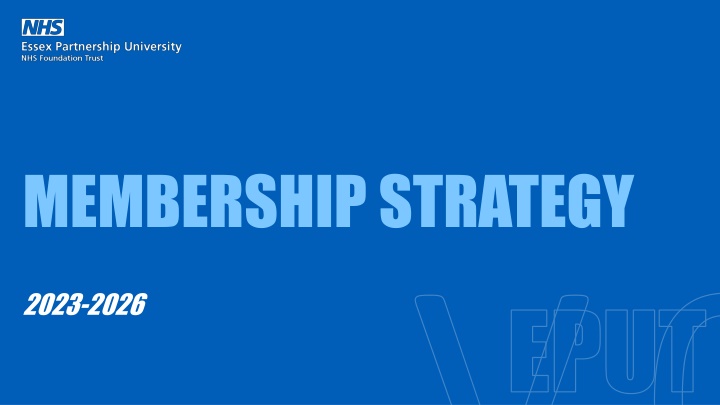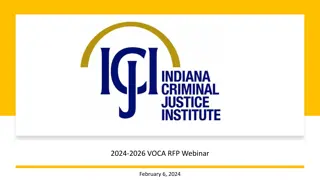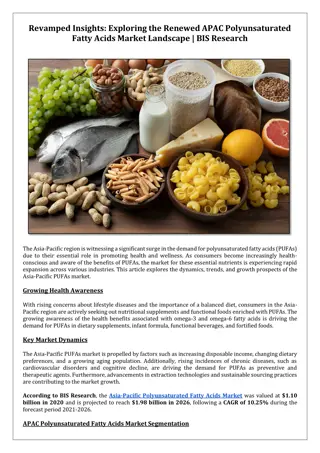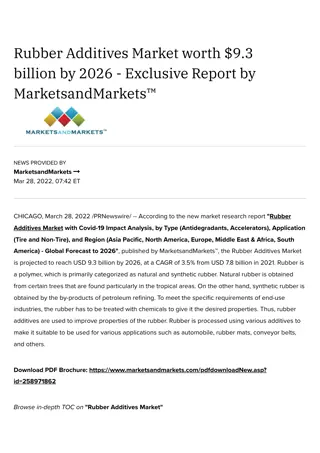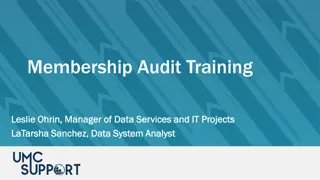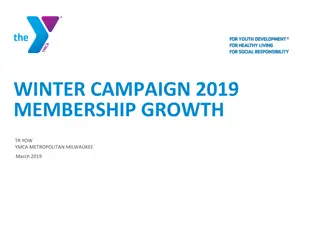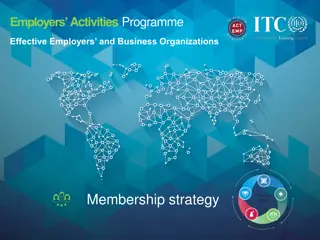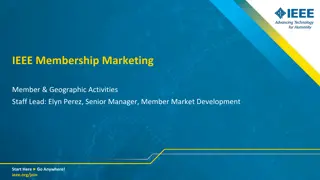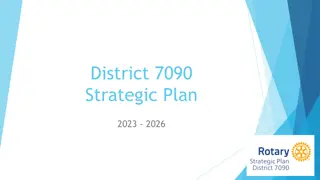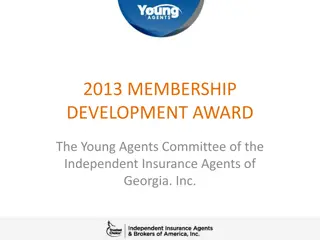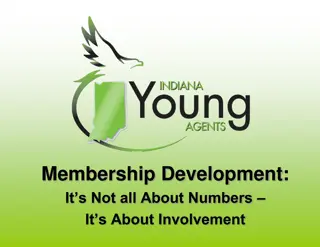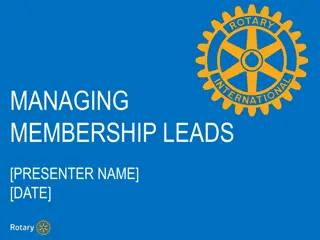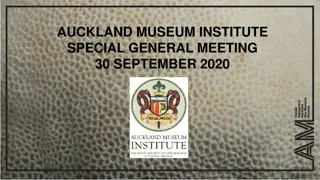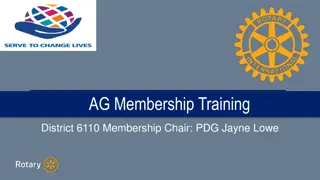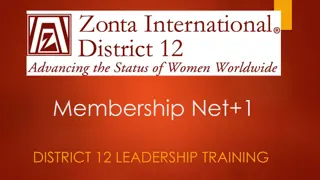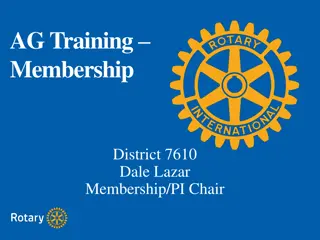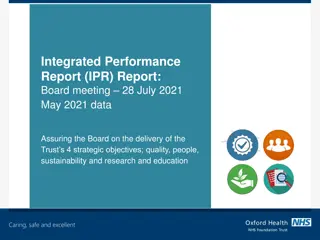EPUT Membership Strategy 2023-2026: Engaging Our Community
Essex Partnership University NHS Foundation Trust values the participation of its members in shaping and improving healthcare services. The Membership Strategy outlines the commitment to engaging with the community, enhancing governance through the Council of Governors, and ensuring the voices of patients, carers, and staff are heard. The strategy highlights the importance of collaboration with stakeholders, setting a vision for the next three years, and addressing challenges to deliver exceptional care. Through a structured approach led by the Membership Committee, EPUT aims to strengthen its connection with members and prioritize inclusive decision-making processes.
Download Presentation

Please find below an Image/Link to download the presentation.
The content on the website is provided AS IS for your information and personal use only. It may not be sold, licensed, or shared on other websites without obtaining consent from the author.If you encounter any issues during the download, it is possible that the publisher has removed the file from their server.
You are allowed to download the files provided on this website for personal or commercial use, subject to the condition that they are used lawfully. All files are the property of their respective owners.
The content on the website is provided AS IS for your information and personal use only. It may not be sold, licensed, or shared on other websites without obtaining consent from the author.
E N D
Presentation Transcript
MEMBERSHIP STRATEGY EPUT 2023-2026
Introduction As a Foundation Trust (FT), Essex Partnership University NHS Foundation Trust is accountable to the local community, the patients it cares for and the people it employs through its membership. By becoming members, local people, patients, carers and our staff can have a say in how services will be designed and delivered, and by becoming or voting for governors, perform a vital role in holding non-executive Board members to account for the performance of the Board. As such an involved, informed, representative and vibrant membership is integral to the anchoring of the Trust to its area and delivering outstanding services that listen to and respond to the needs of the community. Members This strategy therefore seeks to: Reiterate the Trust s commitment to its membership Council of Governors Board of Directors Outline our vision for the next three years EPUT Understand our current membership picture and the challenges Identify actions to ensure we meet the challenges. 25.10.21 25.10.21 P.2 P.2
Council of Governors Membership Committee The Trust has a Membership Committee, which is a sub-committee of the Council of Governors. The committee meets on a quarterly basis and is made up of governors interested in engaging with members. The Committee is the main conduit for engaging with our members and will be the lead committee in monitoring and implementing this strategy. The Committee is currently chaired by Mark Dale, Public Governor for Essex Mid and South. Mark says: This Membership Strategy will embed what we will do as a Trust to engage, inform and to enable the diverse people and communities who use all of our services or have family, friends and supporters who take on the important responsibilities of caring to have a meaningful and lasting voice. We will develop new ways to work in collaboration with partner NHS providers, our social care colleagues, and the community and voluntary sector to underpin this aim. Because what we do together really matters. 25.10.21 25.10.21 P.3 P.3
Why Membership Matters This strategy sets out our commitment for engagement with our Foundation Trust members and the communities we serve. Their involvement is important in helping us to achieve our goal of providing outstanding care. We have developed this strategy based on good practice from other Foundation Trusts and NHS Providers, and statutory and regulatory requirements. The development of the strategy has been led by our Council of Governors through its Membership Committee. As an NHS Foundation Trust, we are accountable to our patients and the public. Our members have a key role in the Trust s governance. They elect representatives to sit on our Council of Governors, which in turn appoints the Chair and other non-executive directors to the Board of Directors and hold the non-executive directors to account for the Board s performance. The strategy is supported by an action plan which sets out what we will do in practice across the next three years to achieve our vision. Members are our staff, our patients and members of the public. We believe that involving our members, patients, and the public in decisions about services is an integral part of meeting the needs of the communities we serve. 25.10.21 25.10.21 P.4 P.4
Our Membership Community Who can be a member? As an EPUT member you will: Public members As a local provider of services we offer all those who have an interest in or connection to the Trust, the opportunity to become a member. This could be as a service user, carer, relative or someone living in the community we serve interested in healthcare. No special skills or experience are required. It is free and open to anyone who is 12 years of age or older. Members come from our geographical constituencies for the purpose of electing governors. Receive information about the Trust Be able to vote for representatives on the Council of Governors and stand for election to the Council of Governors (for those 16 years of age or older) Be able to take part in surveys and consultations Participate in patient involvement initiatives. One of our aims through this strategy is to improve our communication with members and add to the benefits above. Staff members Our staff colleagues are also members of the Trust. Any staff colleagues employed by the Trust on permanent contracts or fixed term contracts of 12 months or longer become a member. Disqualification from membership We want to encourage the widest possible membership but where a member s actions or behaviour are detrimental to the Trust or its values, for example acts of verbal or physical abuse against our staff, it may be necessary for the Trust to revoke their membership. 25.10.21 P.5 P.5
The Benefits of being a Member Benefits for EPUT Benefits for members Allows the Trust to engage more people in the community as part of a range of approaches Get involved in health care in a way that allows members to choose what involvement they give. Builds members understanding of the health care system and how it s changing to help make informed decisions about care and the advice and support to give people in the community. advice and support to give people in the community Get involved in healthcare in a way that allows members to choose what involvement they give Builds members understanding of the healthcare system and how it s changing to help make informed decisions about care and the Greater understanding of the local population managing expectations and sharing knowledge of optimum health and care pathways Help to improve the health of the community by sharing information about health and services at the Trust such as sharing and liking the Trust s social posts Share key health messages with the widest number of people. Access to an extensive database of public who have expressed a willingness to give their views 25.10.21 P.6 P.6
The Benefits of being a Member Benefits for members Benefits for EPUT Supports the Trust and its continued development of quality services. A direct line to members of the community to explain developments Get involved in health care in a way that allows members to choose what involvement they give. Builds members understanding of the health care system and how it s changing to help make informed decisions about care and the advice and support to give people in the community. and help its continued development Help drive continued quality improvement at the Trust by sharing experience and giving views Greater understanding of the local population managing expectations and sharing knowledge of optimum health and care pathways Be a friend of the Trust. Learn directly about developments at the Trust. Support the Trust Link from volunteering to membership can also operate the other way. Could potentially help to break down barriers to considering health careers A first step to getting further involved, e.g. by becoming a volunteer or governor, or developing understanding for those considering a career in healthcare 25.10.21 P.7 P.7
The Benefits of being a Member Benefits for EPUT Benefits for members Take a part in the governance of the Trust by voting in elections for governors who play an important role in the Trust Trust staff develop an interest in governor positions, encouraging strong candidates reflecting the whole community Get involved in health care in a way that allows members to choose what involvement they give. Builds members understanding of the health care system and how it s changing to help make informed decisions about care and the advice and support to give people in the community. the performance of the Board Voting for governors to sit on the Council and play a critical role in representing members and holding the non-executive directors to account for Engaged and informed governors are key to supporting the delivery of Trust objectives 25.10.21 P.8 P.8
The Foundation Trust membership, via the Council of Governors, can have a say in how services are designed and delivered. This will have a vital impact on how patients experience services provided by EPUT. The Membership Strategy directly impacts two of the Trust s strategic objectives: Patient experience / social impact EPUT Strategic Objective 3: We will work together with our partners to make our services better EPUT Strategic Objective 4: We will help our communities to thrive Partners include individuals with an interest in services, either through direct experience or through the experience of family members and friends. The experiences and views of these individuals, provided to their governor representatives, can help shape how services are developed and improve overall patient experience. Members are also part of the local community and can often represent the views of the local community without realising. When people access local services, they automatically have an opinion on how these services are provided. This kind of intelligence, included as part of other areas of involvement, can help shape services by understanding how people experience them and where the improvements can be made. This combined can help improve services for the local community and provide real social impact. 25.10.21 25.10.21 P.9 P.9
Council of Governors Members' views and opinions are heard through the Council of Governors, whose role is to represent the interests of members and hold the non-executive directors to account for the performance of the Board. The Council of Governors is made up of 19 elected public governors, six elected staff governors and five appointed governors from stakeholder or partner organisations. All public members aged 16 or over are allowed to stand as a governor or vote for a governor. All staff colleague members are able to stand as a governor or vote for a governor within their staff constituency. Staff (6) Public (19) There are also local stakeholder organisations that are represented on the Council of Governors. Appointed (5) 25.10.21 25.10.21 P.10 P.10
Council of Governors The Council of Governors is responsible for: Representing the interests of members and the public Holding the non-executive directors to account for the performance of the Board of Directors Appointing the Chair and other non-executive directors, and holding them to account for the performance of the Board Approving the appointment of the Chief Executive by the non-executive directors Receiving the Trust s Annual Report and Accounts Appointing the Trust s external auditors The Trust is committed to developing and supporting governors to enable them to carry out their role and contribute fully to the work of the Council of Governors Further details of the composition of the Council of Governors are set out later in this document. 25.10.21 25.10.21 P.11 P.11
Our Membership Priorities Establish a membership that is representative of the population served by EPUT Communicate effectively with members and ensure their views are represented within EPUT Develop a process to ensure membership engagement operates across the system and with Integrated Care Boards 25.10.21 25.10.21 P.12 P.12
Priority 1: What we will do: Establish a membership that is representative of the population served by EPUT Understand the demographics of the population served by EPUT and compare against the membership of the Trust. The members, whether they are Foundation Trust members or members of the public, are fundamental to the way we operate as a Foundation Trust. We are accountable to our members, so it is important to ensure our formal Foundation Trust membership is representative of the population we serve. Identify and undertake engagement with members of the public to increase membership in any areas that are not represented. Regularly review membership demographics to confirm engagement is working and identify solutions where it is not working. We can do this by ensuring we understand our local demographics and target areas that are under-represented to ensure their voices are heard. EPUT Strategic Objective 4: We will help our communities to thrive We can then continue to monitor so we understand the impact of our engagement work we are doing on the diversity and representation of our membership. 25.10.21 25.10.21 P.13 P.13
Priority 2: What we will do: Communicate effectively with members and ensure their views are represented within EPUT One of the key roles of the Council of Governors is to represent the views and interests of the members and members of the public. Develop a membership communications strategy which: Establishes regular communication between governors and members/members of the public. Creates a two-way channel so that members have a voice and have clear feedback on issues raised. One of the fundamental parts of this is to have a regular dialogue with members to ensure their views are understood and can form part of any conversations governors have with the Board of Directors. EPUT Strategic Objective 3: We will work together with our partners to make our services better) It s important we regularly communicate with members and this is an area that we need to strengthen. Any communications need to be two-way. EPUT Strategic Objective 4: We will help our communities to thrive 25.10.21 25.10.21 P.14 P.14
Priority 3: What we will do: Membership in the context of system working Understand the role of Foundation Trusts and membership as part of system working. The Health and Care Act 2022 has changed the emphasis for Foundation Trusts. Foundation Trusts are now required to make any decisions in the context of the wider healthcare system. Ensure the views of members of the Foundation Trust are represented in decision making at a system level. Any views expressed by members must be represented at both the organisation and the wider healthcare system. Communicate with governors and members to encourage understanding of system working and the importance and impact of their views. System working and Integrated Care Boards is relatively new to the NHS, so it is important to establish our aims whilst also being agile as system working matures over the next few years. EPUT Strategic Objective 3: We will work together with our partners to make our services better 25.10.21 25.10.21 P.15 P.15
Implementing the Strategy and Measuring Success Implementation: We have developed an action plan which sets out the practical steps we will take in each year to implement the strategy so that it is clear how we will put our plans into action. The action plan is set out as an appendix to this strategy. It will evolve and develop as the strategy is implemented. We envisage a phased approach over three years to deliver and fully implement the strategy, with the first year focused on laying the essential groundwork and years two and three focusing on embedding engagement. It is important the strategy remains a live document and can change as we move through the year. Evaluating success: The Council of Governors is ultimately responsible for the delivery of the strategy and it will be supported in this by the Membership Committee which will undertake the detailed monitoring of implementation and will report regularly to the Council on this. 25.10.21 25.10.21 P.16 P.16
Implementing the Strategy and Measuring Success The principal ways in which we will assess the success of the strategy will include: Analysing the profile of the Trust s membership We will conduct this analysis on a regular basis and look in depth at the profile of the Trust s public membership and identify any under-represented groups. This will help us to understand whether our targeted campaigns have been successful and whether we are succeeding in maintaining the size and diversity of our membership. The results will be analysed by the Membership Committee. Analysing involvement We also need to understand the extent to which our efforts in promoting a more active and involved public and staff colleague membership have been successful. To do this, we will look at new ways of analysing involvement, not just using the membership database statistics. This can include engagement with social media posts, attendance at engagement events, surveys with the members to assess their views. Analysing impact We want to understand and evaluate the impact of the membership on the Trust s services. Surveys of members will assist with this. We can also look at wider outcomes that are not just restricted to membership, for example, if we engage with members about a subject such as volunteers, has that encouraged some people to volunteer that have not previously? Or if we engage with members about carers, has that directly helped anyone in their role as a carer or seeking carer support? 25.10.21 25.10.21 P.17 P.17
Appendix 1: Composition of the Council of Governors Constituency/No Governors Constituency Area Essex Mid & South 9 Governors Basildon Borough Council Braintree District Council Brentwood Borough Council Castle Point Borough Council Chelmsford City Council Colchester Borough Council Suffolk County Council Tendring District Council Borough of Broxbourne Council East Herts District Council Epping Forest District Council Harlow Council Bedford Borough Council Central Bedfordshire Council Any other Council in England Maldon District Council Rochford District Council Southend-on-Sea City Council Thurrock Council North East Essex & Suffolk 3 Governors West Essex & Herts 5 Governors North Herts District Council Stevenage Borough Council Uttlesford District Council Welwyn Hatfield Borough Council Luton Borough Council Milton Keynes Council Milton Keynes, Bedfordshire & Luton and Rest of England 2 Governors 25.10.21 25.10.21 P.18 P.18
Appendix 1: Composition of the Council of Governors Constituency/No Governors Constituency Area Staff Governors 6 Governors Registered Medical Practitioners Registered Dentists Registered Nurses Registered Midwives Healthcare Professionals Social Workers Support Workers Corporate Staff Appointed Governors 5 Governors Essex County Council Southend-on-Sea City Council Thurrock Council Anglia Ruskin and Essex Universities Third Sector/Voluntary Sector 25.10.21 25.10.21 P.19 P.19
Appendix 2: Membership Strategy Action Plan How we will deliver the priority Priority Key Objective Year One Year Two Year Three Once the data is established, analyse the information to identify gaps in membership representation to focus engagement. Understand the demographics of the population served by EPUT and compare against the membership of the Trust. Establish an accurate source of demographical information for the population served by EPUT, which can be regularly updated. Priority 1: Identify and undertake engagement with members of the public to increase membership in any areas that are not represented. Undertake focused engagement with members of the public to increase membership in any areas that are not fully represented. Establish a Membership that is representative of the population served by EPUT. Continually review membership against demographical data to determine if engagement is having a positive effect on membership. Review overall demographics and engagement outcomes to establish if the membership is representative of the wider population and revise any engagement activity as required. Regularly review membership demographics to confirm engagement is working or identify solutions where it is not working. Review and alter any engagement depending on the outcome of the analysis. 25.10.21 25.10.21 P.20 P.20
Appendix 2: Membership Strategy Action Plan How we will deliver the priority Priority Key Objective Year One Year Two Year Three Develop a communications and marketing plan to establish different channels of communication. Review communications and marketing plan to ensure it is delivering expected communication levels and adjust as required. Develop a membership communications strategy Implement communications and marketing plan. Establish a who, what, where, when of communication as part of the communications plan. Priority 2: Communicate effectively with members and ensure their views are represented within EPUT Identify opportunities for governors to communicate directly with members and members of the public, ensuring we are providing them with the right information and resources needed. Establishes regular communication between governors and members/ members of the public. Governors regularly engage with members and gather their views. Review levels of engagement and take action as required. Develop a process for ensuring the views of the members are represented and this captured and fed-back to them. Review the process to ensure there is evidence of membership views being represented in the Trust. Creates a two-way channel so that members have a voice and have clear feedback on issues raised. 25.10.21 25.10.21 P.21 P.21
Appendix 2: Membership Strategy Action Plan How we will deliver the priority Priority Key Objective Year Two Year Three Year One Understand the role of a Foundation Trust and membership as part of system working and be able to articulate this to governors and members. Understand the role of Foundation Trust s and membership as part of system working. Review and update governors and members as the role of system working and ICBs develops. Priority 3: Membership in the context of system working Ensure the views of members of the Foundation Trust are represented in decision making at a system level. Establish processes to ensure any views expressed by members are represented to the ICBs and throughout the wider system. Communicate with governors and members to encourage understanding of system working and the importance and impact of their views. Regularly engage with the ICBs and ICS on a regular basis and ensure this information is shared with governors and members. Review and adjust as required 25.10.21 25.10.21 P.22 P.22
